15. Three made by Whimsy Wood Puzzles
Frugal laser-cut puzzles from an American company; Seaside Cottage and Bottles Glasses & Grapes by anonymous artists, and Monet’s Apples and Pears (about 5000 words; 38 photos)
[Update: Jeff Campbell has now retired and Whimsy Wood Puzzles are no longer being made.]
This is part of what I think of as my “frugal alternatives” sub-series of this newsletter/blog project. Nominally it is a review of three particular puzzles, but actually my intent is to introduce you to the jigsaws made by Whimsy Wood Puzzles. Whimsy is a small laser-cutting workshop in Phoenix, Arizona that makes and sells 1/4” (6mm) thick puzzles for surprisingly low prices. And they include free shipping to American addresses.
How inexpensive are they? The company’s list price for 350 piece grid-cut puzzles is $49USD; $79 for 500 piece straight-edge puzzles cut in elaborate and tricky cutting patterns; and $99 for 500 piece puzzles in which the tricky cutting includes elaborate open edges that include many dropout voids. That is considerable less expensive than other puzzles of comparable quality.
For comparison, almost all other 1/4” thick 500 piece puzzles are currently priced at over $125 USD. Further, Whimsy Wood Puzzles always has some closeout puzzles or weekly specials available at 50% off their regular prices (and still with free shipping.) As I write this, Whimsy has 17 puzzles available at this deep discount price. Unfortunately, Whimsy does not ship internationally, however a limited selection of their puzzles is available worldwide through a Canadian distributer (see below.)
Whimsy seems to operate under a business model that is quite different from any other wood puzzle maker so I will begin with information about the company itself and a general overview of its products before I present my walkthroughs of the three puzzles. Because Whimsy’s website includes photos of their cutting designs I am not putting their assembly below a below a spoiler warning.
I have no affiliation with the Whimsy Wood Puzzles company or the Canadian distributer except as a paying customer.
Whimsy Wood Puzzles
Unlike most founders of laser-cut puzzle companies, Jeff Campbell is not a cutting designer. He is a book publisher. Whimsy is identified on its homepage as a division of Tau Publishing, LLC, but it might be more accurate to think of it as a spinoff from Jeff’s other company. Tau Publishing is a small religious book publishing company that he founded in 2002, and it is entirely devoted to making and selling books and gifts related to the Catholic faith, specializing in Franciscan literature in particular. Jeff runs both companies basically as one-person operations.
As far as I know, Whimsy is the only current wood jigsaw puzzle maker that began as an offshoot of a printing or publishing company, but those roots are fully consistent with jigsaw puzzling’s heritage. In fact most of the 19th and 20th century factory-style wood puzzle manufacturers began as offshoots of publishing firms. These roots make sense when you think about it: Aside from the wood and its cutting, well-printed artwork is the most important component of any jigsaw puzzle.
Whimsy’s puzzles are indeed well printed, on glossy acid-free 80# cover-stock paper. This enables rich, vibrant colours and images with crisp details (if those things are included in the original artwork.) But while glossy paper is very good for image sharpness, unless you have ideal lighting it can create reflections that can interfere with assembly, and with trying to photograph puzzles. (Printing on matte paper reduces those problems but it also reduces the sharpness of images.)
Unfortunately, as all fans of vintage wood puzzles know, printing on paper also makes the puzzles more fragile and susceptible to paper peeling and wear along the edges over time. Paper peeling can be due either to the adhesive failing, or to the soft layers of the paper itself failing, leaving paper layers still attached to both the wood substrate and to the tough thin coating that holds the surface image. As discussed below, I encountered a minor amount of that latter kind of peeling in two of my Whimsy puzzles (and one of those was my own fault.)
These potential problem are not specific to Whimsy puzzles, and several premium wood puzzles have their images printed on paper. But I have not yet seen peeling or as much wear in the other new printed-on-paper puzzles I have assembled. (I am very used to seeing it in vintage puzzles.) I presume that some types of paper are more susceptible to wear than others, and perhaps the thick 80# cover stock paper that Whimsy uses might make their puzzles more susceptible.
I don’t want to make this problem sound worse than it is. I had a bit of peeling on only two connectors from Apples and Grapes. I had a bigger problem with Bottles Glasses and Grapes, but that was my own fault (due to trying an ill-considered way to try to turn the puzzle over when it was upside-down.) In both cases I was able to do satisfactory repairs with a bit of glue, using a toothpick as the applicator.
Both of those puzzles also show a bit of wear along the paper edges even though this was the first time these puzzles were ever assembled. It shows up as the paper being scuffed or worn away next to dark printing, thus showing the white paper fibres. It is only visible where the printing is very dark. In those cases my repair method involved either re-gluing the paper down or darkening the exposed area with coloured pencils. That was easy and it worked quite well.
As I have mentioned in previous reviews in this series, I personally prefer UV printing directly onto the wood for puzzles, especially for post-impressionist paintings like these. That kind of printing gives a subtle 3D effect and seems to bring the brush strokes to life. The ink also strengthens the wood edges on the tops of the pieces, helping to prevent chips. I don’t mind chips on the puzzle back, but ones that impinge the image I consider to be a significant detriment. I consider UV printing on wood to be a bonus, rather than that printing on paper is a shortcoming. It might be changing, but printing onto paper is still the more common practice among most of the premium puzzle-makers.
Whimsy has a wide variety of styles of artwork currently available, mainly using photography and paintings by both named and un-named commercial artists. Puzzles in which the price is shown as “from $49” are available in both a 350 piece grid-cut version for that price and a 450-500 piece puzzle for $79 that uses one of the company’s elaborate and tricky cutting patterns. In both cases the finished puzzle is 12.375” x 18.375”. Puzzles are also available in 100 and 1000 pieces, and some in a newly-introduced 12” x 15” 250 piece size.
For the most part the religious orientation of the Jeff’s publishing company does not spill over into Whimsy Wooden Puzzles’ selection of artwork. The puzzle images do not reflect religious themes except for those in its catalog under the sub-heading “Saints”, and three more religious puzzles made by Whimsy that are only available `from Tau Publishing’s separate online bookstore (at 50% off.) Even the Christmas theme puzzles are more likely to feature secular aspects of the holiday than Nativity story images.
Most laser-cut puzzle makers try to develop a relatively large catalog of puzzle images on their websites, which they either keep in stock or make to order. Only the larger well-established firms seem to discontinue puzzles regularly to make room for new offerings. Whimsy takes a different approach. They have a relatively small number of puzzles available in their current offerings because they discontinue puzzles regularly and sell them for 50% off. They also have weekly specials in which a few puzzles are also available for 50% off.
From a technical perspective, the wood and laser cutting is as good as any of the premium laser-cut puzzle companies that I have assembled so far. The puzzles are made from locally-sourced 1/4” (6mm) birch or alder MDF (medium-density fibreboard) with wood veneer on the back side. The cutting swaths from vaporized wood are typical of high-quality laser cutting. The puzzles here all have a moderate degree of scorching around the cuts on the back-side (which Jeff has told me is now a resolved issue) but they have no discolouration on the front sides.
But there are a few catches. The company does not ship internationally. However, I was able to by my Whimsy puzzles from a selection of them offered by Canadian distributer Tri-M Specialty Products, and Tri-M does ship worldwide. That company’s pricing system for the various brands of wood puzzles they carry is different from Whimsy’s because they have a seemingly-permanent buy-2-get-1-free sale for all of the wooden jigsaw puzzles that they carry. (Other companies they carry include DaVICI, Zen, Bewilderness, and Nervous System.) Tri-M also has 50% off for puzzles that they are discontinuing (for which the 3-for-2 sale does not apply.) The shipping cost to me here in Canada is quite inexpensive, and delivery is very fast, but I do not know anything about their shipping fees to other destinations.
Whimsy Wood Puzzles’ company’s name is somewhat misleading since many of their cutting designs do not include whimsy pieces (except for the company’s trademark signature piece which is a script W.) In fact, even for the cutting patterns that do have them, figural pieces do not seem to be the highlight of Whimsy’s cutting designs. The designer’s main focus seems to be on creating interlocking, interesting cutting, with rounded connectors often disguised and integrated into an overall swirling cut. This produces convoluted piece shapes that, for me, make assembly more fun.
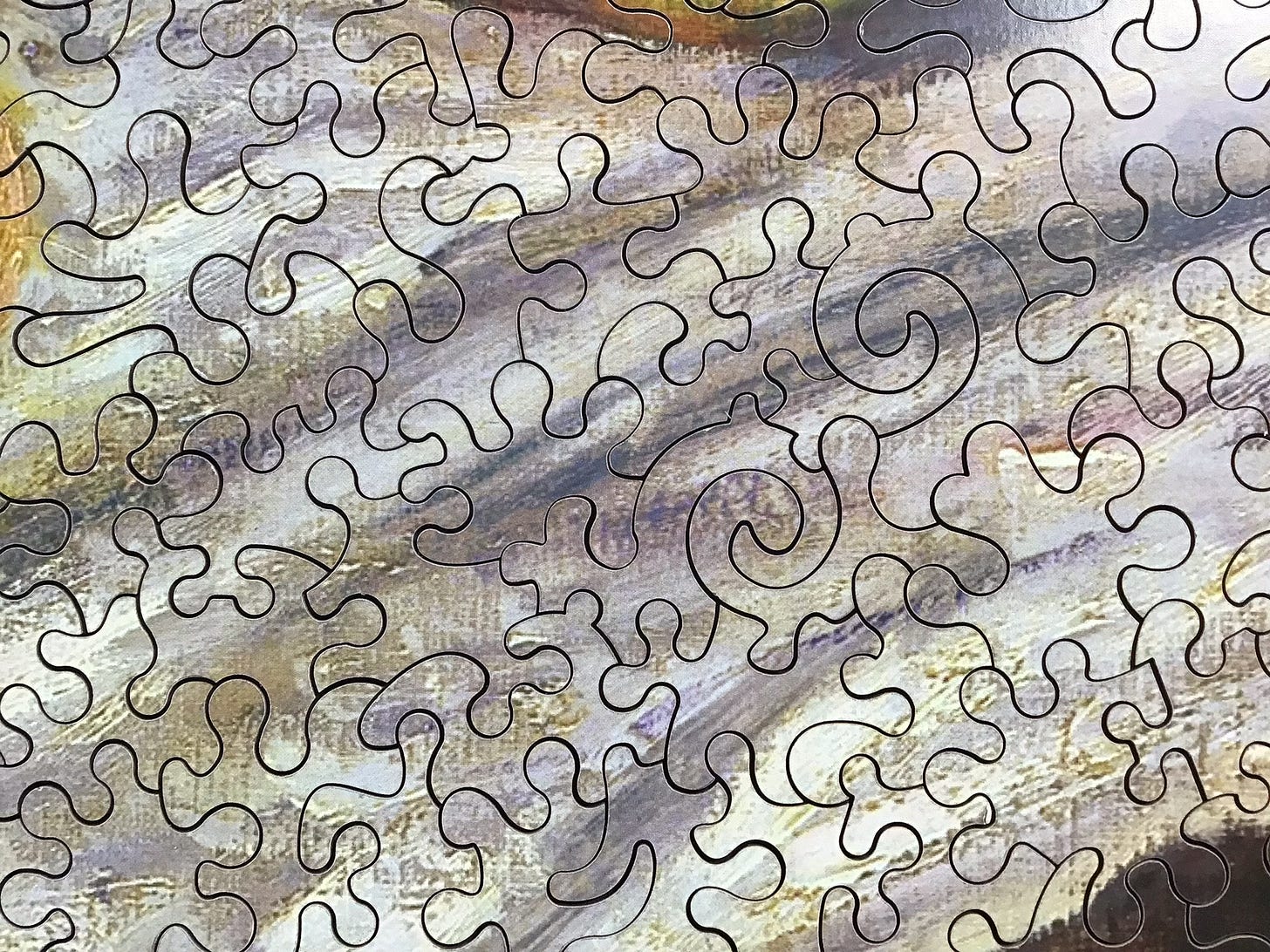
Personally, while I love attractive well-placed figural pieces that relate to a puzzle image’s subject matter, I think that the whimsies themselves have become too dominant of a feature in many companies’ offerings. I enjoyed assembling two of these puzzles despite their absence, and in fact, it was a nice break from the current vogue of whimsy-madness. The third mini-puzzle (Bottles Glasses and Grapes) does have attractive whimsies, and in abundance! I counted over 25 whimsies in a 100 piece puzzle.
Unfortunately the Whimsy company has considerably fewer cutting patterns than it has images, so the same cutting patterns often recur in different puzzles. Since Jeff is not a cutting designer himself, these patterns are designed and programmed under contract by an unnamed graphic designer. Jeff told me that the cutting patterns cost him up to $1000 each and he currently has 48 of them, 20 of which are for his 450-500 piece puzzles. Fortunately, all of the cutting patterns appear to be well-designed and are quite different from each other, and each is given a distinctive name. The name and a picture of the cutting pattern assigned to each puzzle image is identified in the online catalog.
I asked Jeff if he is willing to let buyers choose a different cutting design instead from those he has available, since that is not mentioned in the online listings. He said that he would be happy to accommodate such requests; just telephone or send him an email telling him what combination you want. But for now, of course, this option is only available for puzzles being bought directly from the company so it is not available for us customers outside of the US.
The cutting-design names include “Tree of Life”, “Stars”, “Great Outdoors”, “Southwestern”, “Steampunk”, “Cats and Dogs", “Butterflies” (which is both tessellated and has a very elaborate border), and “Geometric” (which, as the name suggests, is rectilinear and “Tetris”-like.) The Whimsy website kindly includes this page that shows several of the company’s various cutting styles.

The cutting patterns of the first two puzzles I am reviewing here are called “Standard” (i.e., similar to a die-cut cardboard puzzle) and “Wildly Whimsy.” I found the latter one to be quite creative and challenging, but counterintuitively it is one of the cutting patterns that does not include figural pieces.
Jeff licenses the rights to use the artwork for all his puzzles, mostly from contemporary artists and photographers or from companies that own the rights to the images. Often those companies prefer to keep their artists anonymous (just as Jeff prefers to keep the name of his contracted graphic designer anonymous.) From my perspective, this anonymity is a minor downside of Whimsy puzzles. I prefer to know the people whose creative achievements I am enjoying.
The boxes that my puzzles came in are pretty basic – they are sturdy and attractive, but basic, more like the boxes that the better cardboard puzzles come in. I see on the website that they have since revised their packaging to include a velvet bag, and they are now introducing a wood box as optional extra-cost feature. (However, from the pictures, the design of the wooden box, which has two knobs on the top, does not look very practical for efficient storage.)
Conclusions
I think that these puzzles are extremely good value – high quality for a low price. Yes, there are less expensive wood jigsaw puzzles available, but they are all either in the 3 or 4 mm thickness range if they are new, and cannot match the rich tactile pleasure of assembling 6mm thick pieces, or they are used vintage puzzles that cannot match the quality of printing and paper that are now almost a standard feature for new jigsaw puzzles and which gives newfound vividness to colours.
The only drawbacks to this good value are that although there is a good selection of different artistic styles in Whimsy’s offerings they are relatively limited compared to the large-scale manufacturers of 1/4” puzzles (like Liberty, Nautilus or FoxSmartBox), the fact that cutting designs are re-used, and (if it matters to you) the packaging does not convey “heirloom” quality as much as most other brands.
I already have one more Whimsy puzzle yet to assemble and I will definitely be buying more of them, but because I am in Canada I have to wait until Tri-M carries more of their puzzles that have both an images I like and a cutting pattern that I haven’t already assembled. No matter how much I like the image, I am far less likely to buy a puzzle if it doesn’t have a cutting pattern that is also new to me.
And now, here are my experiences in assembling three puzzles made by Whimsy Wood Puzzles that have led to the above recommendation:
Seaside Cottage
laser-cut Whimsy Wood Puzzles (Phoenix, Arizona)
unidentified artist printed on glossy paper
350 pieces; 12.4” x 18.4” (31x 47 cm) average 4.2 cm/piece 6mm (1/4”) mdf
I assembled this puzzle in April, about a month before I began this newsletter/blog project. This review is adapted from one that I posted in the Wooden Jigsaw Puzzle Club group on Facebook at that time. Because of that I do not have any photos taken during assembly so I cannot give an assembly walkthrough for this puzzle.
I ordered this puzzle by accident from Tri-M Specialty Products late on a Friday evening. I had meant to order it in their free-flowing “Wildly Whimsy” cut rather than this simple one that Whimsy calls “Standard”, by which they appear to mean “like the familiar cutting style of a premium cardboard jigsaw puzzle.” (Note: the cause of the error was entirely my own late-night carelessness. It wasn’t caused by any confusion due to the company’s name.) I noticed my mistake about an hour later when I received an automated email confirmation of my order. I sent an email message to Tri-M immediately to try to change my order, but their shipping software worked faster over the weekend than their Monday catching-up with emails.
I had ordered it because I wanted to try out the Whimsy brand and Tri-M was having a really good sale. Right out of the box I was impressed by the quality of this puzzle, and even before I completed assembling it I ordered two more Whimsy puzzles in the company’s more elaborate cutting designs, including Apples and Grapes.
As you can see from these close-up photos, the printing quality is sharp and the colours are vibrant.
When I first opened the box instead of the waft of smokiness that I expected there was an odour that reminded me of industrial solvents. The scent was off-putting but not obnoxious, and faded as I sorted the pieces and assembled the puzzle. I asked Jeff about this and he was mystified as to how this could have happened. He said that he has not gotten any feedback about this before.
During assembly, which was, well, standard, I came to appreciate this painting by an unnamed artist. With its loose brush strokes and glimpses through to the texture of the canvass in some areas, the post-impressionist image works very well for a puzzle. And those colours! The painting does a great job in capturing the mid-day lighting of a place where the sun rises much higher in the sky than it does here in Canada.
Here is the completed puzzle, and its back side:
Seaside Cottage was the 15th wood puzzle that I assembled, and as I mentioned earlier I bought “standard cut” version of it by accident. I found the puzzle to be a fun and easy assembly, mainly because of the bright cheer colours.
It had that luxurious tactile feel being a 1/4” inch wood puzzle, but the homogeneity of the pieces’ size and shapes was a constant reminder of my silly mistake. I missed the ingenious cutting that makes assembly of wood puzzles so much fun. I wouldn’t buy another wooden puzzle in this cutting style, but it did demonstrate that despite their low prices Whimsy Wood Puzzles does indeed produce premium quality products.
And despite the simple cutting I’ll probably assemble this puzzle again, probably on some winter day after weeks of the overcast that is typical for Victoria at that time of year when I would like a reminder of sunshine.
Apples and Grapes
laser-cut Whimsy Wood Puzzles
Claude Monet (1880)
500 pieces 12.4” x 18.4” (31x 47 cm) average 2.9 cm/piece 6mm (1/4”) mdf
As mentioned in the above review, I bought Apples and Grapes even before I had completed Seaside Cottage. I was attracted by its 500 piece size and that the fact that it was painted by Claude Monet.
I don’t really know what motivated me to choose this particular puzzle for assembly now, other than that it was October and the weather seemed to be turning, and I was in the mood for another Monet painting. I also thought that it was about time for me to post a review about the Whimsy Wood Puzzles company. When I saw the box on my to-do shelves I realized that (aided by having taped a Christmas card over most of the picture on the top of the box) I had already done a particularly good job of forgetting what the image of this puzzle was. I remembered that it was a still life, but only because of the title did I know that that it was fruit rather than flowers.
In fact, my forgetfulness was perhaps too effective this time. In retrospect, I think a puzzle with this image, with its muted colours and house-bound subject matter, would have been more suitable for mid-winter rather than what has turned out to be a very warm and pleasant October here in Victoria.
First impressions and sorting
My first impression when I opened the box, other than the campfire smell, was that it sure seemed to have a lot of dark pieces. I gently poured them out of the box and began flipping to see what kinds of colour variations I had to work with. There were a lot of black, dark blue-gray, and charcoal-gray ones. The second largest grouping was mottled greenish-yellow/rust-red. There were relatively few pieces that were predominately orange-red (presumably apples), and quite a few pieces were light coloured, often with a mauve tinge. All of the colours seemed quite subdued – there were no bright or primary colours.
Perhaps the most surprising thing, considering the brand name and the fact that this cut-design is called “wildly whimsy” was that was that there were no whimsy pieces except for one that I recognized from the previous puzzle as being their signature piece. (I probably knew that this would be the case when I ordered the puzzle, but that was another thing I had forgotten.)
The strategy of building colour/texture islands and working outwards from them did not look very promising. I also noticed that there were not many straight-line cuts except for ones that were potential edge pieces. The pieces had a lot of convoluted shapes, almost all of the cutting being tight curves, looking like lots of potential connectors. The cutting style remind me a bit of the vintage puzzle I had to give up on in June because it was too difficult for my then-level of puzzling experience and patience. Even before sorting I knew that I was in for a challenge.
I decided that I would begin the old school way, by attempting to assemble the edge as a frame and work my way inward. That would require a lot of working space so I tried an approach to sorting that was new to me – I got three large bowls from the kitchen and put the non-edge black and other very dark pieces in one of them, the mottled greenish/rust ones in another, and the light-coloured ones in the third bowl.
On the board I organized the potential edge pieces (along the bottom) by colour, and grouped together the ones with brighter orange/red that I presumed to be apples (on the left) and the miscellaneous pieces that were hard to classify on the right.
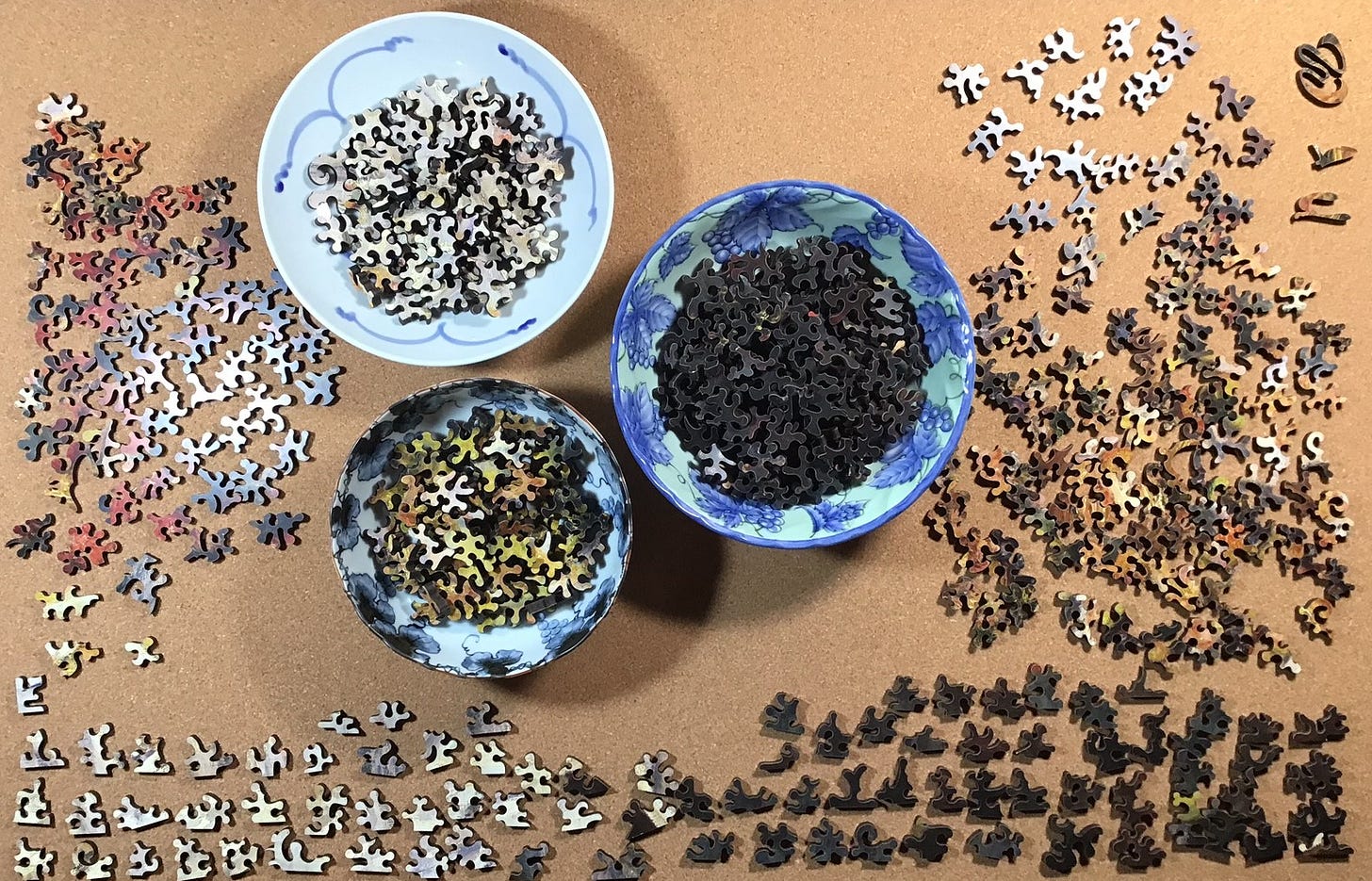
Assembly
I didn’t know whether the whitish pieces would go on the top or bottom of the image, but the brush-strokes suggested bottom – perhaps a tablecloth. I wasn’t too surprised that there were a number of edge pieces that I had missed during my sorting. I am used to cutting designs disguising the edge pieces.
It was a bit of serendipity, not intention, that I accidently got a quick glimpse of the edges of the picture of the top of the box. That confirmed my tablecloth theory regarding the whitish pieces. I moved the black edge pieces to the top of my puzzle-board, and decided to take the rest of the whitish ones from their bowl. The process of moving them soon revealed missing edge pieces.
As I was getting more working room I took the greenish-rust pieces from their bowl and put them on the board, and I re-arranged the white pieces. This next photo is mostly progress that came quickly from that reorganizing and from consolidating the linear clusters already shown in the previous photo. I think that other than the tablecloth progress on the lower right, only about five pieces had been added.
Back to working on the tablecloth pieces:
Things slowed down a lot about here. Assembly was beginning to feel rather tedious, especially since other than the yellow apple I did not recognize what the greenish-rust blobs were. (The basket was fairly easy to identify as such, but it was only much later that I recognized the blobs as impressionist grapes. The colour of the basket is very similar to that of the grapes.)
It never got to the point of feeling frustrated, but it did feel a bit like I-just-want-to-get-this-over-with. I think I might not have felt this way if the colours had been brighter, or if the painting had sharp contrasts instead of mostly merging gradually from one colour to another disguising the image’s various components.
In retrospect, I think this melancholy is not due to the puzzle itself, although the cutting pattern is indeed challenging, but that Monet might have instilled this painting with his own feelings about being cooped-up indoors when nature was filling the outdoor landscapes with novel scenes, colours, and effects of light and shadow. (More about this in the discussion about the painting, below.)
Notice in this next photo that I began building apples on the left side of the board, and that I now have enough working room on the board for the very dark pieces that had been in the last bowl. (I learned not to use bowls for sorting. I’m going to get another small cork bulletin board for an overflow situation like this.)
Progress was still pretty slow at this stage but the feeling of tediousness dissipated. I was still working on making apple-islands, but also tackling the very dark areas. There are subtle colour gradients in the darkness, with some areas having a bluish or brownish tinge.
My apple-clusters are now mostly complete. It is just a matter of figuring out where they fit in . . .
. . . and I still have a lot of very dark pieces left too.
I got the apples in place and then finishing up the fruity part of the puzzle went pretty quickly, using up all of the remaining pieces that had any bit of non-dark colour in them. Then all that was left to assemble were black pieces . . .
. . . which continued to go pretty slowly, but produced a strong feeling of accomplishment when I completed it!

The painting
Monet painted Apples and Grapes near the end of 1879. That had been a difficult year for him. His beloved wife Camille died in September shortly after giving birth to their second son Michel. Monet combined households with his longtime friend Alice Hoschedé , whose bankrupt husband had abandoned her with their six children, and Alice (who later became Mrs. Monet) tended the 10-person household which was now dependent entirely upon sales of Claude’s paintings. Fortunately, the impressionist movement’ fourth exhibition that year had been successful and his paintings were finally becoming en vogue.
The winter of 1879/80 was a particularly cold one in France - still one of the harshest in history. That may or may not have relieved his inevitable depression. It was one of the infrequent years in which the Seine River completely froze and he painted many scenes of the rare sight under various lighting conditions. But it also meant many days in which the whole combined household was home-bound in their house in Vétheuil, downriver from Paris.
The image on this puzzle is a cropped version of one of several still-lifes that Monet painted during its stormy beginning of that winter, including three of apples and grapes.
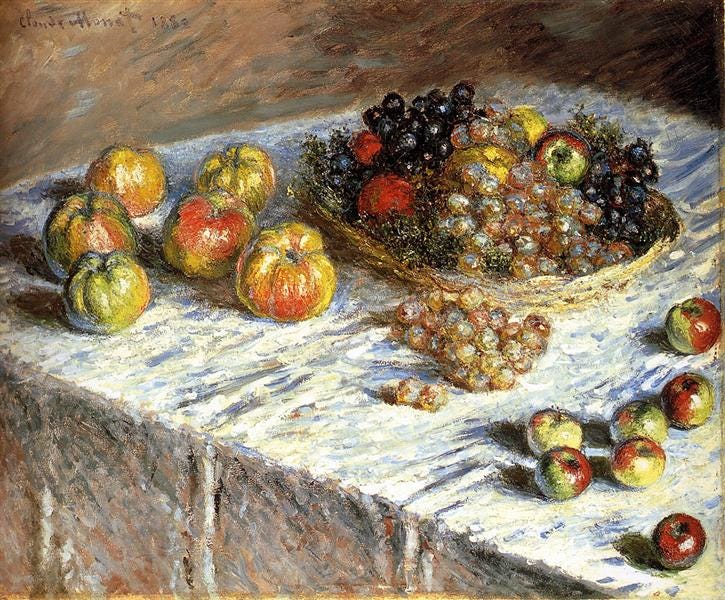
For the most part, still-lifes are not a type of paintings that the impressionists are primarily known for, but they did play an important role in their artistic survival and development. They were reliable cash cows. At the time, still life paintings were very popular and they could be sold more easily and command higher prices than their beloved landscape paintings.
I found several companies offering prints and posters of Monet`s full Apples and Grapes online. Most have its colours juiced up to appear brighter than the original, which is in the Metropolitan Museum of Art.


Although cropping a Monet painting seems like heresy I can understand why Jeff chose to use this cropped detail version of the painting for a puzzle: It centers the bowl of fruit as a focal point and avoids the large dark expanse of darkness along the top and in the upper right of the original composition. If I can add to that heresy, perhaps juiced-up colours would also have been a good choice for puzzling purposes.
[Pictoral digression: During that winter, between storms Monet painted landscapes in a en pleine aire frenzy. Here are just three of them:



End of pictoral digression.]
Bottles Glasses and Grapes (mini-puzzle)
laser-cut Whimsy Wood Puzzles (Phoenix, Arizona, USA)
unidentified artist printed on paper
100 pieces 7.75” x 11.75” (19.5 x 30 cm) average 5.8 cm/piece 6mm (1/4”) mdf
The other two puzzles did not have whimsies, despite the company’s name. This 100 piece mini-puzzle has at least 25 of them! Including some multi-piece ones!
Since this essay had evolved from being a review of just one puzzle (Apples and Grapes) to becoming a review of Whimsy Wood Puzzles in general I decided at the last minute to assemble this small 100 piece one to see if my conclusions about the quality of the company’s puzzles would be validated.
As it turns out, this puzzle demonstrates even better than the others just how deep, rich and vibrant can be the colours, and how sharp and clear the images, from Whimsy’s printing. It also confirms that all other aspects of its manufacture live up the expectations set by those first two Whimsy puzzles, and for the first time, it shows that Whimsy’s graphic designer is no slouch at creating figural pieces. I’m even more impressed now than before with the value-for-money that Whimsy Wood Puzzles has to offer.
Here’s the walk-through. Because there are so few pieces, and just to try something different, when I flipped the pieces over I didn’t do any initial sorting at all . . .
. . . and as I continued, I would move the loose pieces to make working space, and put clusters where I thought they should go, but I still did not try to organize the loose pieces:
Ta daaaa!
I really like the rich colours and cubist style of this painting by an unidentified artist. A colour-line cutting design (i.e., cutting along the lines separating colours of different elements in the painting to make assembly more difficult) would suit this image perfectly! But Jeff can’t do that because his model for keeping costs (and hence, prices) low requires that he needs to amortize his cutting designs over several puzzles.
After the puzzle was assembled I used a photo of it to do an google image search. That worked fine in the sense that it showed that many online printing companies sell prints of this painting and others that appear to be by the same artist. But, as with Seaside Cottage, none of the online sources give the name of the artist, or even the name of the painting.








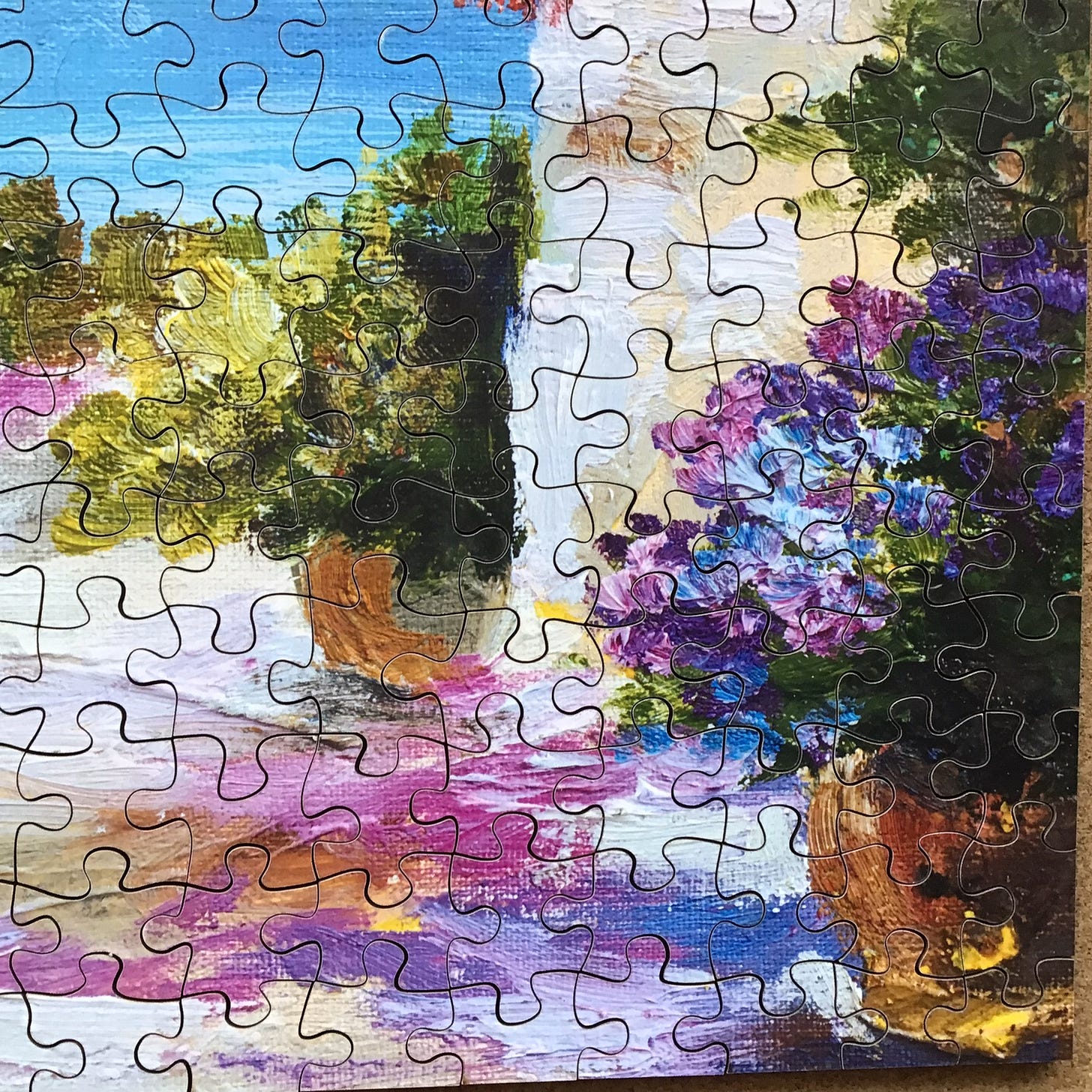
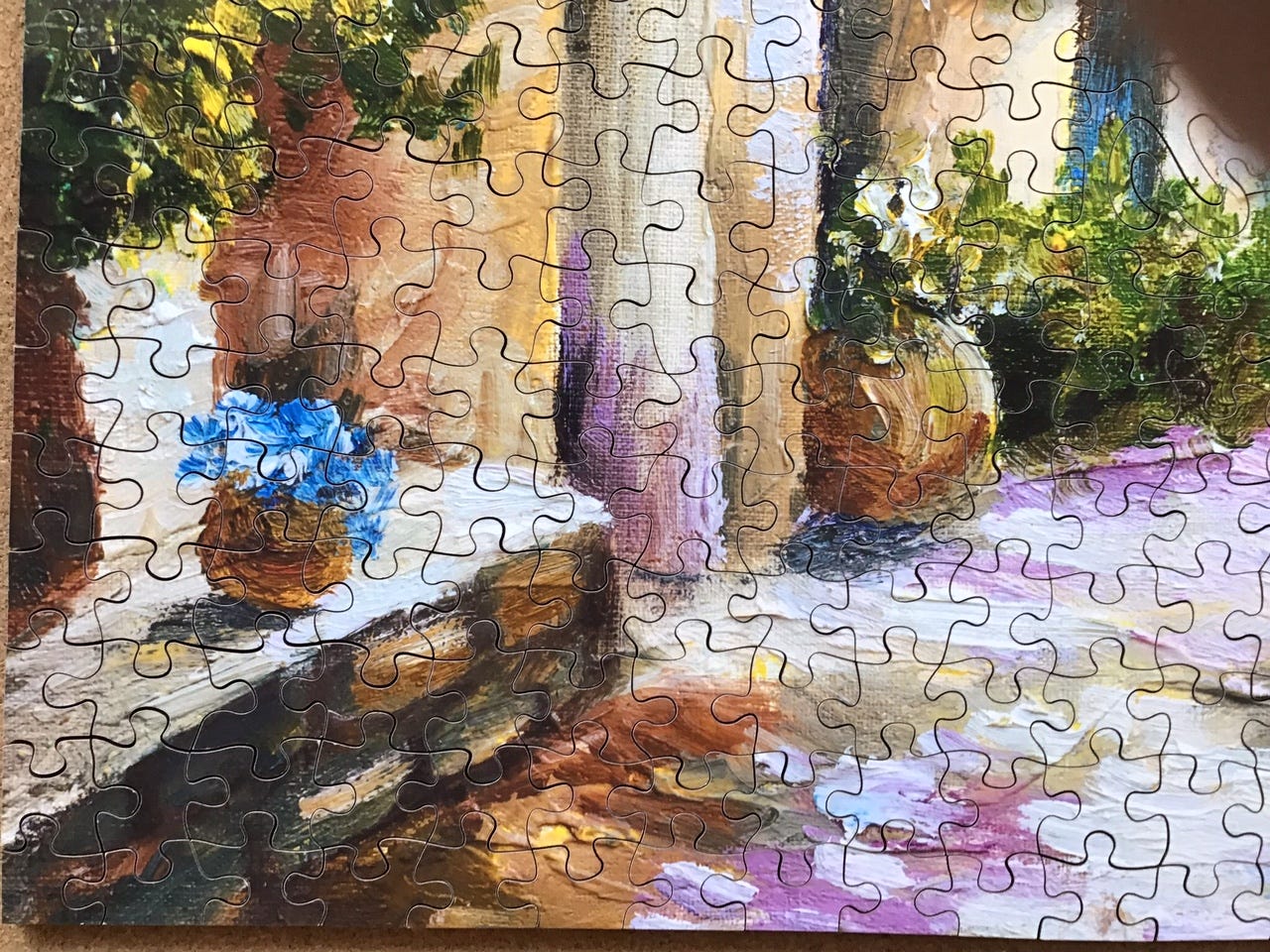









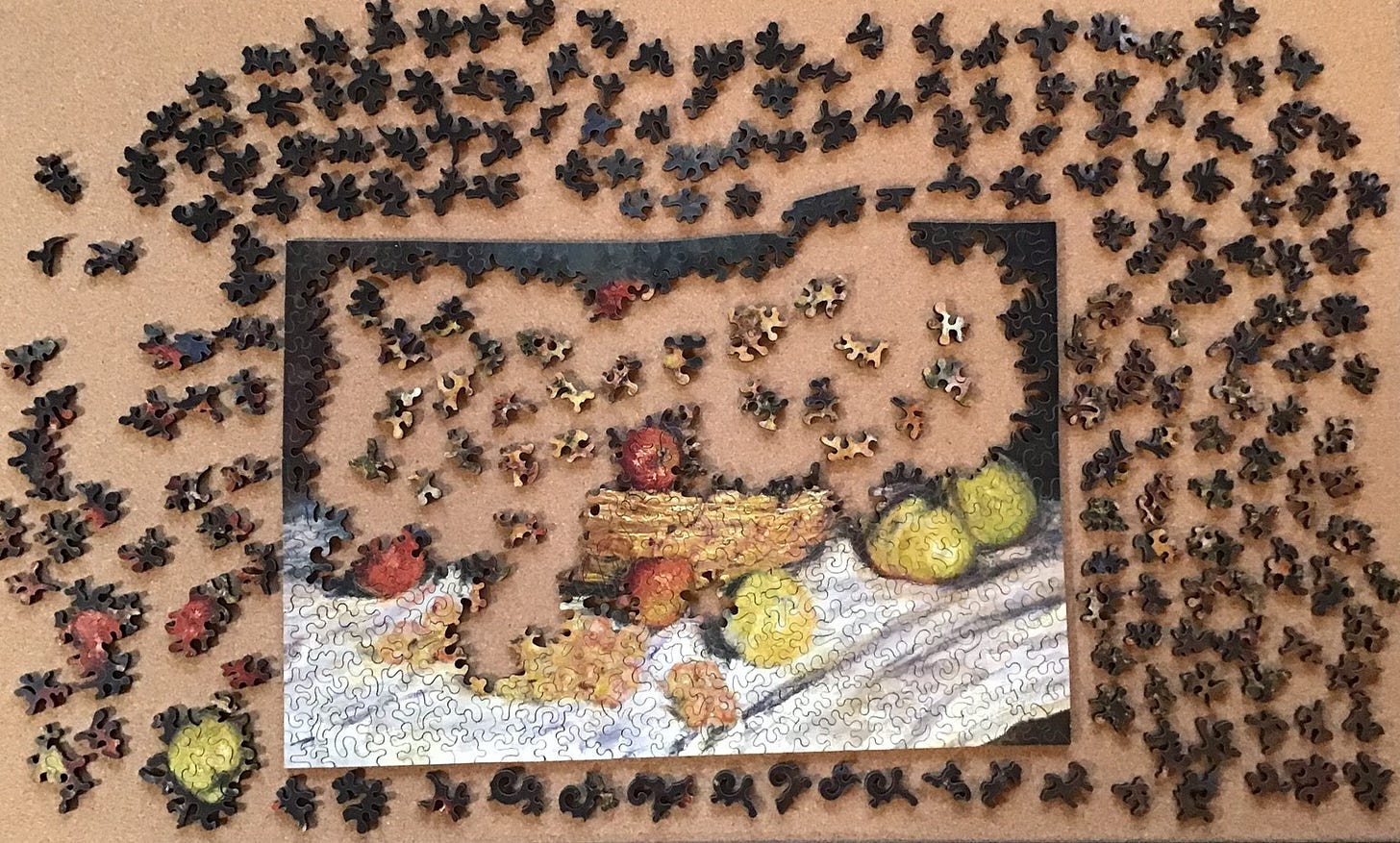

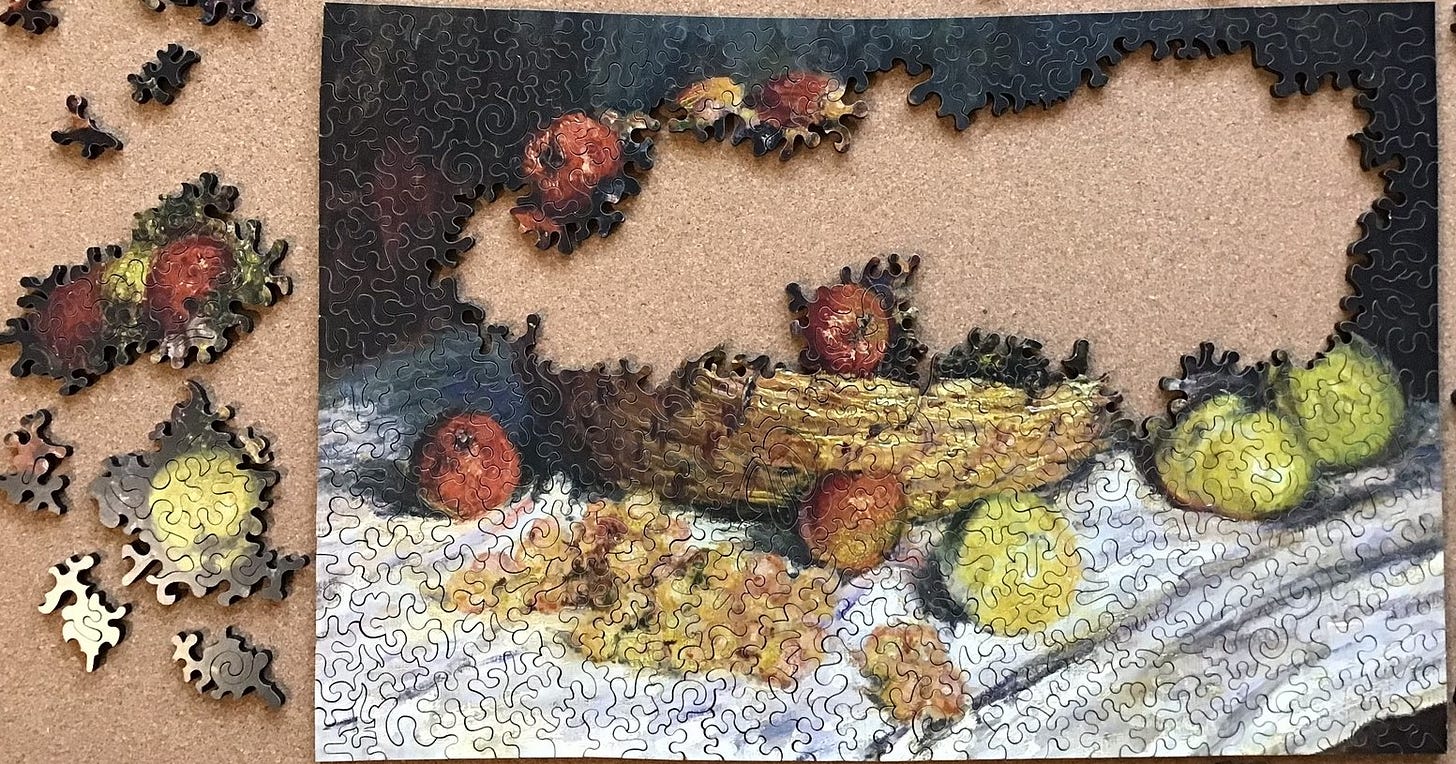





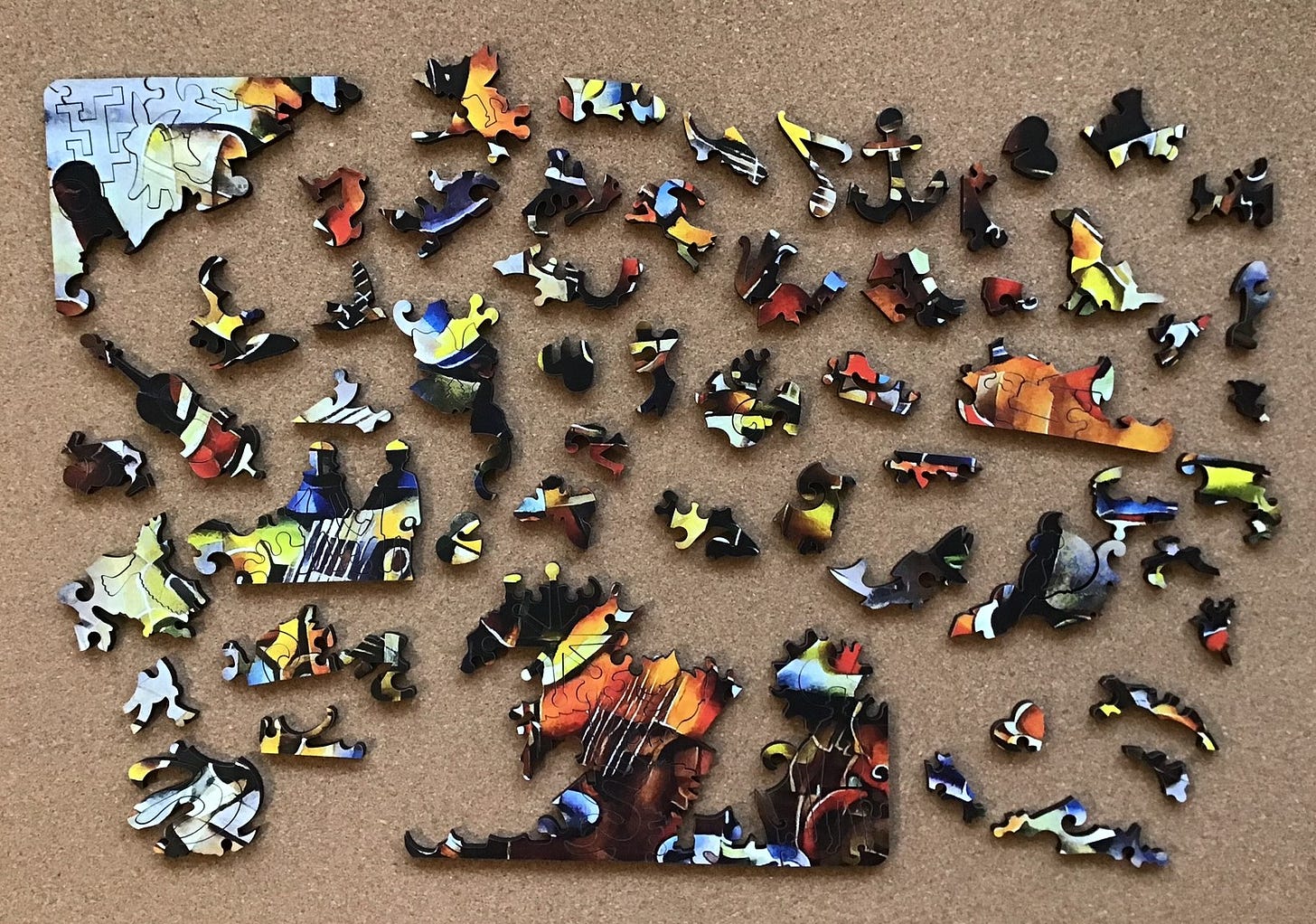
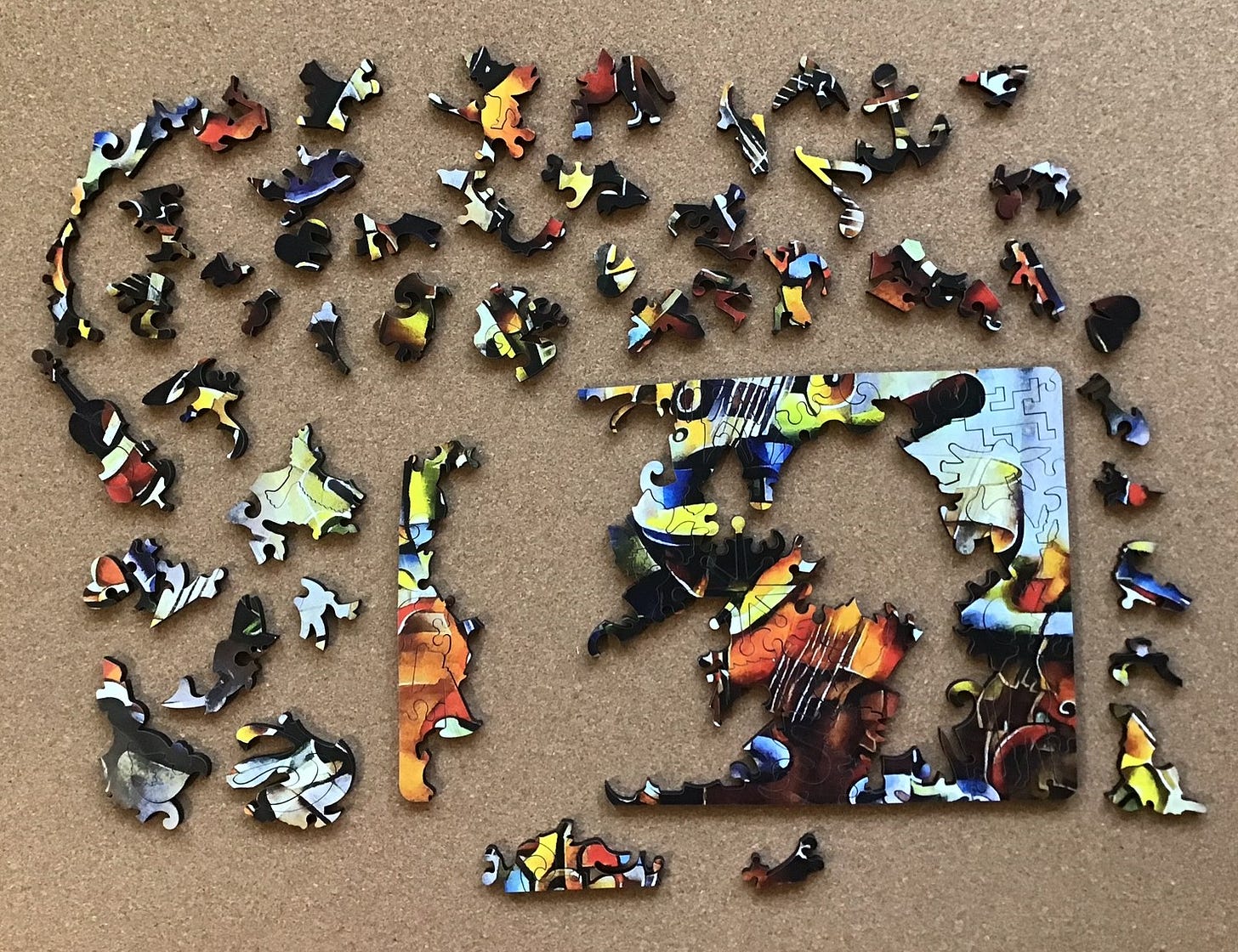
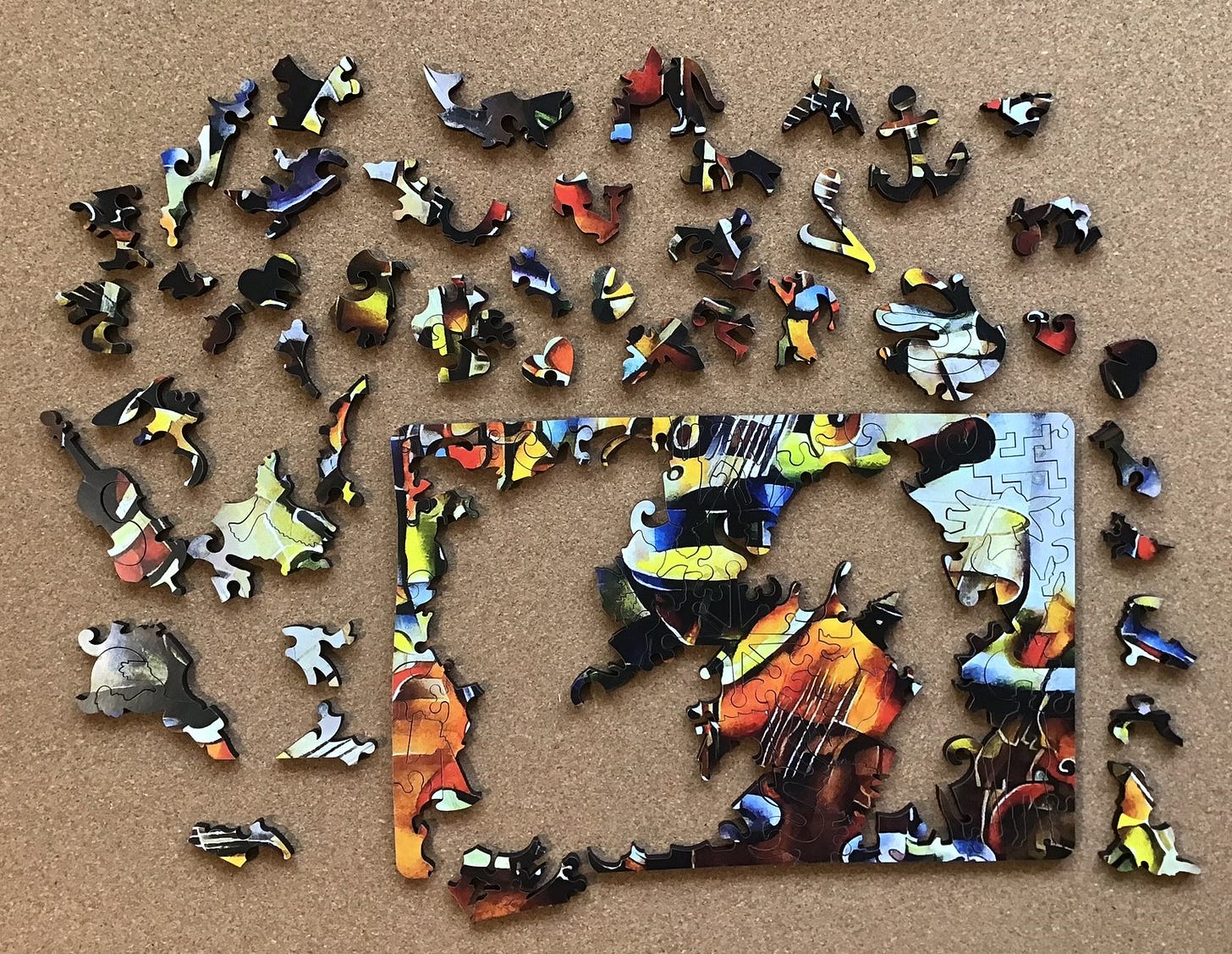



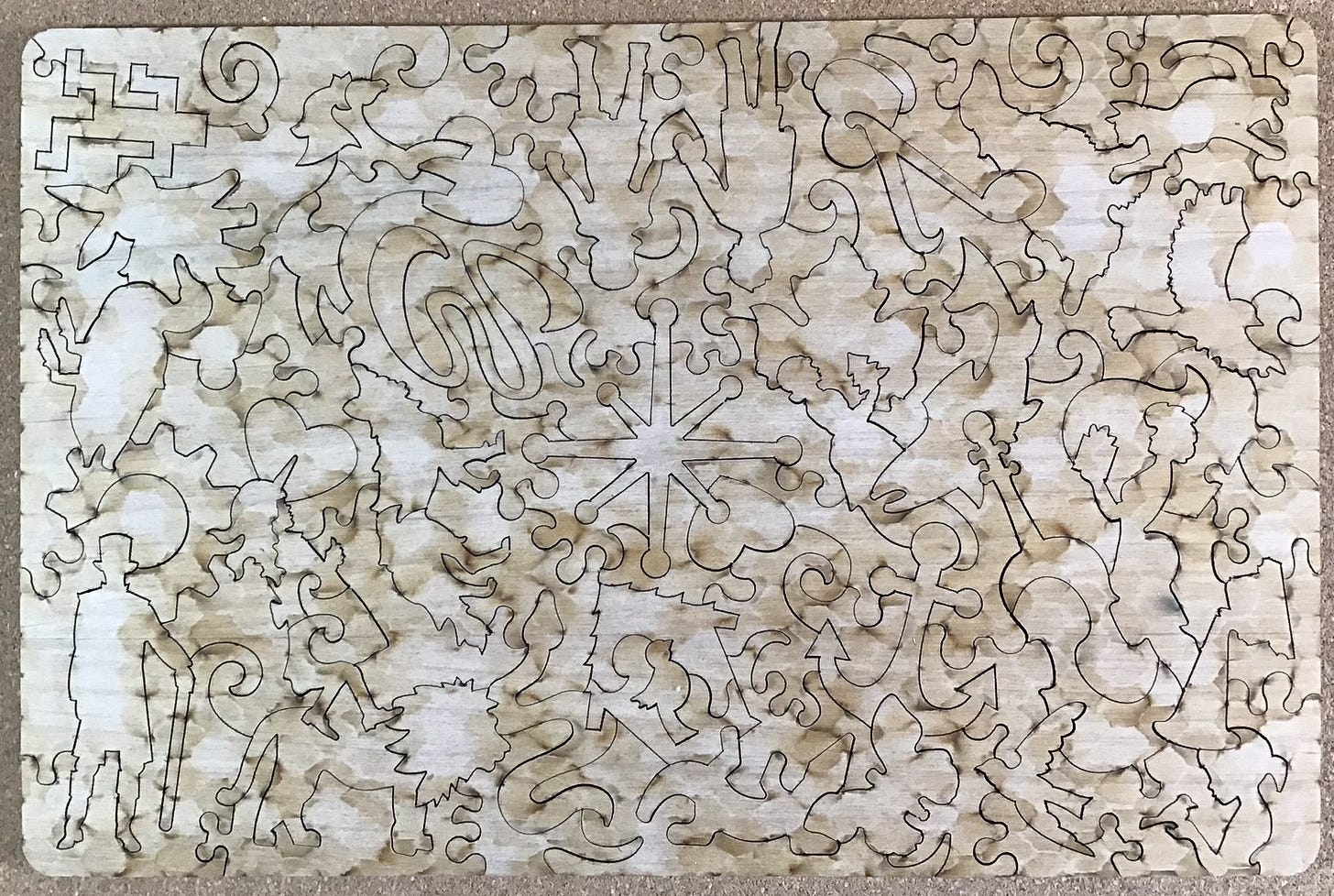
Well done, Bill! I especially enjoyed the approximately "first third" of this posting in which you gave detailed information about the Whimsy company. Jeff Campbell sounds like a really interesting character with a very special combination of interests. Maybe you could have a custom order from him delivered to a US address, where you could pick it up when you next travel into Washington State, say, or to one of those film festivals you've attended with Wendy. I'm not trying to send you into the States, of course; I'm just betting you'd find a reason to go south sooner than I would.
When you got to the actual three-puzzle comparison, the one that captured my affection was Apples and Grapes. I will add, though, that I agree with you that, in general, I'd lioke to know the name of the pictorial artists. You see, I might actually have said that I liked Bottles and Grapes best if I'd had an artist's name to ponder/savour to go with that puzzle. It's a little like my feeling that I enjoy poetry more when I know who wrote it. As won is pondering/savouring anything creative, it's nice to at least have a nail or a hook where you can "hang your hat."
Thanks, again for today's posting. Cheers, Greg
Thanks, Greg. There are a lot of Small American wood puzzle companies that do not ship internationally, at least partly because e-commerce for small businesses is still in its infancy and the Post Office rates favour large-volume shippers. As far as I can tell, to get the best deal for international customers small businesses need to buy shipping from a broker who buys it from the US Post Office at a volume discount (e.g., try.easyship.com and pirateship.com) and re-sells it at up to an 80% discount from the retail mailing cost. Is that crazy or what?!? Most proprietors don’t have the time or knowledge to deal with that.
Hopefully either the e-commerce system or the US Post Office will mature. But as it is now, shipping to Canada from the UK is cheaper than from the States, and shipping from China is much much cheaper!
As you can tell by the research that often accompanies my reviews, I agree about wanting to get to know about the artists. I don’t know why the companies that act as brokers for commercial artists keep them anonymous.